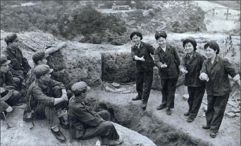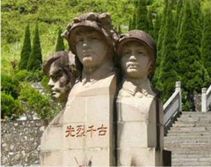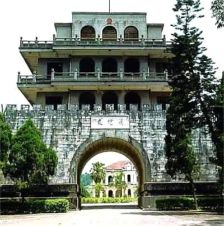VIETNAM'S BLOODY DEFEAT OF CHINA
(SALEM, Ore.) - China lost a significant war in 1979 against Vietnam, though many people in the west do not realize this important history. This side of Vietnam that is rarely recognized involves the country's willingness to defeat the barbaric Khmer Rouge neighbors in Cambodia after the U.S. war in SE Asia. For this China invaded Vietnam, only to lose and retreat after 29 days, ultimately abandoning their military aggression.
Let's back up to 1970, when the U.S. was six years into the Vietnam War; the year that American forces invaded Cambodia, which borders both North and South Vietnam. Communist forces fighting American military units; North Vietnamese Army and Viet Cong guerrillas, used Cambodia as a refuge and passageway. They would enter this country from the north, and show up in the U.S. controlled southern areas.
In 1973 a cease fire was called in Vietnam. In 1975 the last U.S. forces pulled out of the country for good, leaving behind only POW's and MIA's.
At this point all of Vietnam was under the control of Communist Hanoi and it has remained that way ever since.
What is interesting is that Vietnam was primarily supported by the USSR during the U.S. war, not by neighboring China as might reasonably be expected. China was a big supporter of Vietnam right until the start of the U.S. war; that is the year China's support of Vietnam ceased.
As Wikipedia states, the Chinese Communist Party and the Viet Minh had a long history. When Vietnam was fighting France in 1950, the recently founded communist People's Republic of China and the Viet Minh enjoyed close relations. The Democratic Republic of Vietnam, and the 'Chinese Military Advisory Group' under Wei Guoqing played an important role in the Viet Minh's defeat of the French military.
Relations between the Soviets and Chinese began to dissolve after the death of Soviet leader Joseph Stalin- who was responsible for the Murder of millions of Russians. Mao Zedong said Nikita Khrushchev made a serious error in a 'Secret Speech' that denounced Stalin. What really got Chairman Mao heated was Khrushchev's support of peaceful co-existence with the west.
The hostilities increased and led to what is known as the 'Sino-Soviet split'.
At this point, just prior to the start of the U.S. Vietnam War, the North Vietnamese still supported China, mainly due to China's support of North Vietnam's re-unification policy; something the Soviet Union had so far remained indifferent to.
China withdrew support from North Vietnam the same year the U.S. war began, in 1964, when Khrushchev's party sent him packing. He was replaced with Leonid Brezhnev as First Secretary and Alexei Kosygin as Premier.
Beginning in 1965, Vietnamese communist loyalty shifted toward the Soviet Union; with both the Soviet Union and China now supplying arms to North Vietnam in their war against South Vietnam and the U.S.
Fallout with Khmer Rouge
The Vietnamese Communists and Pol Pot's Khmer Rouge worked together in the beginning, but the relations unraveled when the Cambodian regime demanded that Vietnam return certain parcels of land to Cambodia that had been "lost" several centuries earlier. Vietnam wasn't interested, and Pol Pot responded by laying waste to ethnic Vietnamese in a massacre inside Cambodia.
It is important to note that the Khmer Rouge committed genocide against people of different races including ethnic Chinese, Vietnamese and Cambodians.
The Soviets ultimately backed the Vietnamese in a war to defeat Pol Pot in Cambodia, following the tragic notorious period of genocide. The People's Republic of China's (PRC) support of Pol Pot caused the USSR to see it all as an opportunity. They backed the seasoned battle forces of the Vietnamese army which easily defeated the genocidal Khmer Rouge.
The Vietnamese knew there could be a reprisal from China, but they chose to take the Soviet support and hoped the show of force would keep the Chinese at bay. In the long run they lost their gamble.
The official Vietnamese invasion of Cambodia happened late in 1978. The Khmer Rouge was inexperienced in combat; their experience was in bullying and murdering the local civilian populace, not in actual military engagement.
By 7 January 1979, Cambodian forces backed by the Vietnamese government, seized the capital Phnom Penh, terminating the Khmer Rouge regime. Pol Pot fled into the jungle and lived for many years. Until 1997 he and a remaining remnant of the Khmer Rouge operated in the border region of Cambodia and Thailand.
The 29 Day War
The only thing missing from China's invasion of Vietnam on 17 February 1979 was aircraft. China rolled across major sections of the Vietnam border with infantry, armor, and artillery. Their 29 day war achieved no substantial victory and failed as a show of force against the Soviet Union.
According to Wikipedia:
Within a single day, the Chinese People's Liberation Army (PLA) had advanced some eight kilometers into Vietnam along a broad front. It then slowed and nearly stalled because of heavy Vietnamese resistance and difficulties within the Chinese supply system. On 21 February, the advance resumed against Cao Bang in the far north and against the all-important regional hub of Lang Son. Chinese troops entered Cao Bang on 27 February, but the city was not secured completely until 2 March. Lang Son fell two days later. On 5 March, the Chinese, saying Vietnam had been sufficiently chastised, announced that the campaign was over. Beijing declared its "lesson" finished and the PLA withdrawal was completed on 16 March.
Vietnam's position in the wake of combat operations, was that Beijing had suffered a military setback if not an outright defeat.
According to GlobalSecurity.org:
The 1979 attack confirmed Hanoi's perception of China as a threat. The PAVN high command henceforth had to assume, for planning purposes, that the Chinese might come again and might not halt in the foothills but might drive on to Hanoi. The border war strengthened Soviet-Vietnamese relations. The Soviet military role in Vietnam increased during the 1980s as the Soviets provided arms to Vietnam; moreover, Soviet ships enjoyed access to the harbors at Danang and Cam Ranh Bay, and Soviet reconnaissance aircraft operated out of Vietnamese airfields. The Vietnamese responded to the Chinese campaign by turning the districts along the China border into "iron fortresses" manned by well-equipped and well-trained paramilitary troops. In all, an estimated 600,000 troops were assigned to counter Chinese operations and to stand ready for another Chinese invasion. The precise dimensions of the frontier operations were difficult to determine, but its monetary cost to Vietnam was considerable.
According to the Website SinoVietnameseWar.com, the legacy of the war is enduring, particularly in Vietnam. In this nation already devastated by two recent wars, the Chinese in all essence, implemented a "scorched-earth policy" as they retreated back to China, causing extensive damage to the Vietnamese countryside and infrastructure.
Villages were reduced to rubble, roads and railroads received damage at the hands of the Chinese.
In Gerald Segal's 1985 book Defending China, it was concluded that China's 1979 war against Vietnam was a complete failure: "China failed to force a Vietnamese withdrawal from [Cambodia], failed to end border clashes, failed to cast doubt on the strength of the Soviet power, failed to dispel the image of China as a paper tiger, and failed to draw the United States into an anti-Soviet coalition."
Still, as Wikipedia relates, Bruce Elleman argued that "one of the primary diplomatic goals behind China's attack was to expose Soviet assurances of military support to Vietnam as a fraud. Seen in this light, Beijing's policy was actually a diplomatic success, since Moscow did not actively intervene, thus showing the practical limitations of the Soviet-Vietnamese military pact... China achieved a strategic victory by minimizing the future possibility of a two-front war against the USSR and Vietnam."
"Border skirmishes continued throughout the 1980s, including a significant skirmish in April of 1984; this saw the first use of the Type 81 Assault Rifle by the Chinese," according to SinoVietnameseWar.com
China-Vietnam War from Vietnamese perspective
China-Vietnam War from Chinese perspective
After years of unsuccessful negotiations, a border pact was finally signed between the two countries in 1999. The exact position of the border was kept secret, problems continued, and Vietnam eventually relinquished the property back to China.
On a positive note, it was announced in December 2007 that the Hanoi-Kunming highway; a landmark in Sino-Vietnamese relations, would be built. The road will cross the border that was once a battlefield for these countries. It should contribute to demilitarizing the border region, as well as facilitating trade and industrial cooperation between the nations, notes SinoVietnameseWar.com.














